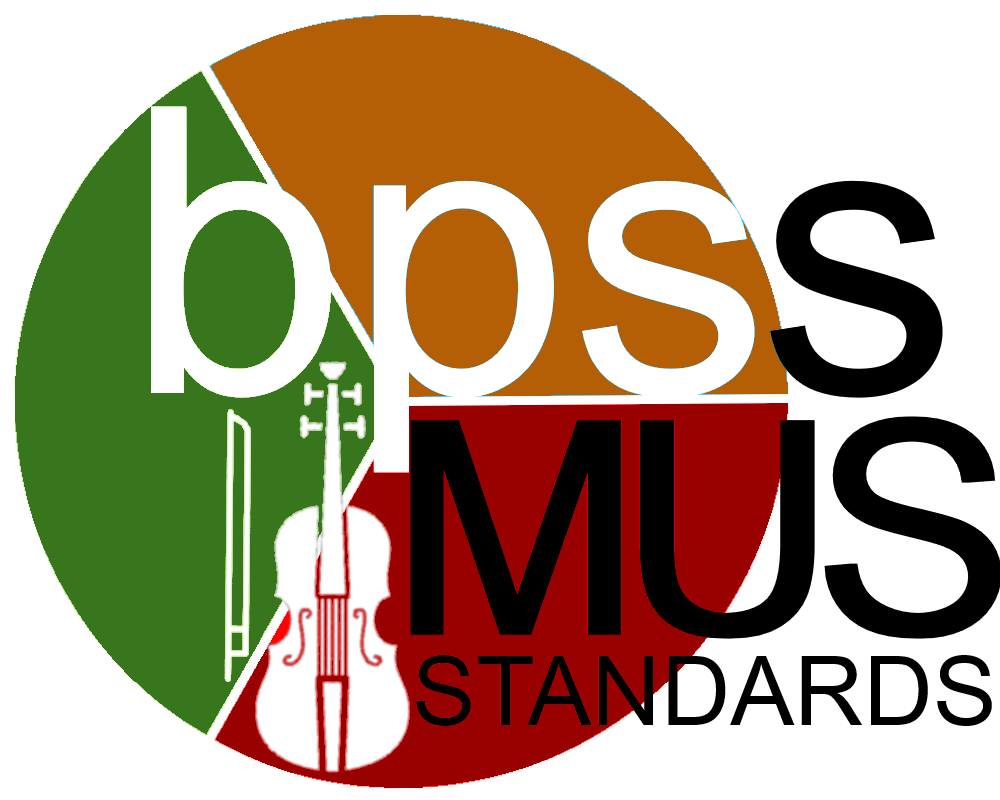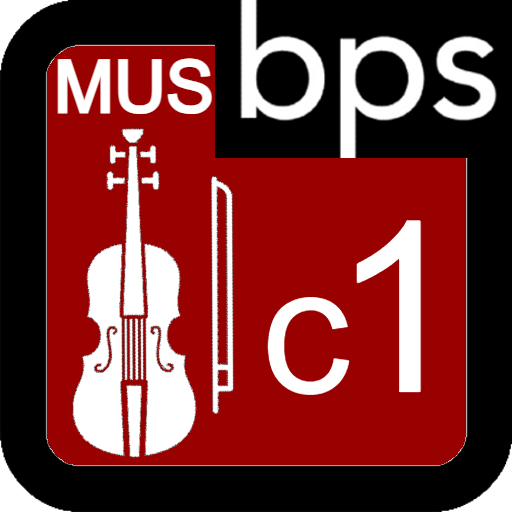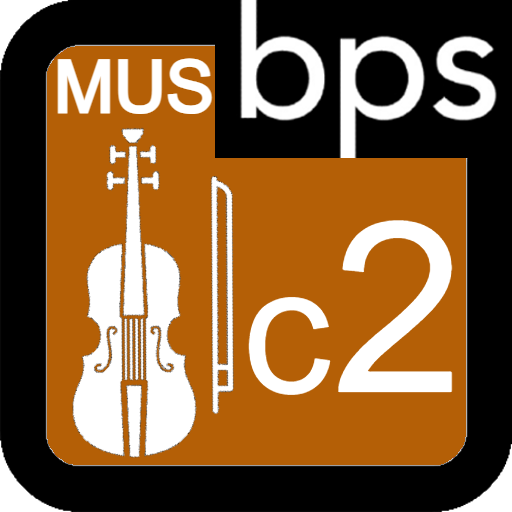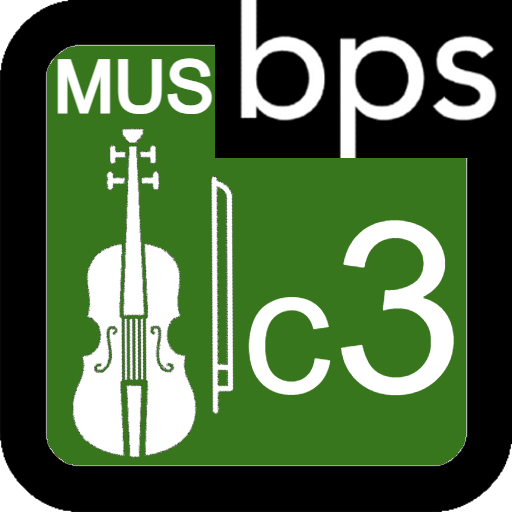MUS-04.c1
 MUS-04.c1
MUS-04.c1 Category

|
(c1) Category 1: Executive Skills and Knowledge
The technical skills and understanding required to physically perform on the instrument, such as body format, bowing, etc.
|
MUS-04.c1.A
Body Format |
MUS-04.c1.B
Left Hand |
MUS-04.c1.C
Right Hand |
| Students establish a lengthened and balanced posture; support instrument without tension, demonstrate ease of motion; format is adjusted for physiological changes due to growth; control of weight distribution, unilateral movement, bilateral movement,
in sitting and standing position.
|
Students perform with correct address and angle of left arm-wrist-hand-finger to instrument, that is balanced and free of tension; independence of fingers; ease of motion and control of finger weight; produces characteristic tone, with vibrato (as
appropriate); shows understanding and ability to apply fingerings, finger patterns, shifting, extensions.
|
Students perform with fluent bowing motion, control of variables (weight, angle, speed, and placement), in a variety of bowing techniques and articulations, with characteristic tone.
|
Calculations
Categories are larger groups of related standards. The category grade is a calculation of all the related standards. Click on the standard name below each category to access the learning targets and rubrics/ proficiency scales for individual
standards within the category. |
|
MUS-04.c1.A

|
4th Grade (MUS) Targeted String Standard
(c1) Category 1: Executive Skills and Knowledge
(A) Body Format
Students perform with a lengthened and balanced posture; supports instrument without tension, demonstrate ease of motion; format is adjusted for physiological changes due to growth; control of weight distribution, unilateral movement, bilateral movement, in sitting and standing position.
|
 Proficiency Scale Proficiency Scale
Learning Targets
- 1.1 Establish posture (sitting and standing) on all instruments.
- 1.2 Basic playing position for violin and viola.
- 1.3 Basic playing position for cello.
- 1.4 Basic playing position for bass.
|
|
MUS-04.c1.B

|
4th Grade (MUS) Targeted String Standard
(c1) Category 1: Executive Skills and Knowledge
(B) Left Hand Skills and Knowledge
Students perform with the correct placement and angle of the left arm-wrist-hand-fingers to the instrument; demonstrate position that is balanced and free of tension; play with independence of fingers, ease of motion and control of finger weight; produce characteristic tone, with vibrato (as appropriate); show understanding and ability to apply fingerings, finger patterns, shifting, extensions.
|
 Proficiency Scale Proficiency Scale
Learning Targets
- 1.1 Initial left hand finger placement
- 1.2 Initial finger patterns
- 1.3 Lateral finger movement
- 1.4 Vertical technique
|
|
MUS-04.c1.C

|
4th Grade (MUS) Targeted String Standard
(c1) Category 1: Executive Skills and Knowledge
(C) Right Hand Skills and Knowledge
Students perform with fluent bowing motion, control of variables (weight, angle, speed, and placement), in a variety of bowing techniques and articulations, with characteristic tone.
|
 Proficiency Scale Proficiency Scale
Learning Targets
- 1.1 Perform pizzicato in guitar position
- 1.2 Perform pizzicato in playing position
- 1.3 Establishing initial bow hold–all instruments
- a. Violin/Viola
- b. Cello/Bass (FB)
- c. Cello/Bass (FB)
- 1.4 Perform pre-bowing exercises
- 1.5 Perform with simple connected (détaché) bow strokes.
- 1.6 Perform with simple separated (staccato) bow strokes.
- 1.7 Direction change
- 1.8 Short slurs
- 1.9 String crossings
- 1.10 Basic bow distribution
- 1.11 Intro to weight, angle, speed, and placement (contact point and part of bow).
|
|
MUS-04.c2
 MUS-04.c2
MUS-04.c2 Category

|
(c2) Category 2: Musicianship Skills and Knowledge
The elements such as understanding of rhythms, aural skills, note-reading skills, etc., that relate to musical understandings.
|
MUS-04.c2.A
Tonal Aural Skills and Ear Training |
MUS-04.c2.B
Rhythmic Aural Skills and Ear Training |
MUS-04.c2.C
Creative Musicianship |
| Students demonstrate the following abilities: matching and manipulating pitch, playing with a sense of tonality, tonal-melodic and tonal-harmonic function (horizontal/vertical relationships/functions of tonality), ear-to-hand skills, aural and kinesthetic
awareness of pitch accuracy and intonation, including and related to improvisation. |
Students perform simple and complex rhythm patterns/functions, with stray pulse/beat, correct sense of meter, metric organization and phrasing, in a variety of meters. |
Students demonstrate creative musicianship skills at all stages of development, including the ability to improvise variations of rhythmic, melodic, and harmonic patterns, within the traditions and standards of a variety of genres and practices:
arrange and compose melodies and harmonies according to specific criteria and guidelines. |
MUS-04.c2.D
Music Literacy |
MUS-04.c2.E
Ensemble Skills |
| Students demonstrate sequential music literacy skills (decoding and comprehension), defined as an association of sound-to-symbol, in a given musical context, which includes: predictive components (understanding of reading based on audition of written
material) and knowledge of symbols and notation related to pitch, rhythm, dynamics, tonality, clef, articulation, etc.) based on the principle that sound comes before sight.
|
Students perform in an ensemble, demonstrating sensitivity and the ability to adjust and maintain a uniform sense of rhythm, tempo, articulation, tone, blend, balance, and dynamics; understand conducting gestures, follow conductor and section leader,
and are able to synchronize bowings. |
Calculations
Categories are larger groups of related standards. The category grade is a calculation of all the related standards. Click on the standard name below each category to access the learning targets and rubrics/ proficiency scales for individual standards within the category. |
|
MUS-04.c2.A

|
4th Grade (MUS) Targeted String Standard
(c2) Category 2: Musicianship Skills and Knowledge
(A) Tonal Aural Skills and Ear Training
Students demonstrate the following abilities: matching and manipulating pitch, playing with a sense of tonality, tonal-melodic and tonal-harmonic function (horizontal/vertical relationships/functions of tonality), ear-to-hand skills, aural and kinesthetic awareness of pitch accuracy and intonation, including and related to improvisation.
|
 Proficiency Scale Proficiency Scale
Learning Targets
- 1.1 Students perform, by ear, melodic tonal patterns (simple patterns and melodies within a tetrachord), in major and minor tonalities (vocally, pizzicato, and/or arco; neutral syllable, then solfege).
- 1.2 Students identify whether two performed melodic tonal patterns are the same or different.
- 1.3 Students correctly associate the words high and low with relative pitch differences (e.g., with the use of Curwen hand symbols and vocal solfege).
- 1.4 Students correctly identify the direction of melodic motion (with a tetrachord).
- 1.5 Students alter melodies and harmonies (major-to-minor, minor-to-major).
- 1.6 Students perform, by ear, primary (tonic and dominant) harmonic tonal patterns (vocally, pizzicato, and/or arco; neutral syllable, then solfege).
- 1.7 Students improvise (vocally, pizzicato, and/or arco) melodic tonal patterns (within a tetrachord; neutral syllable, then solfege).
|
|
MUS-04.c2.B

|
4th Grade (MUS) Targeted String Standard
(c2) Category 2: Musicianship Skills and Knowledge
(B) Rhythmic Aural Skills and Ear Training
Students perform simple and complex rhythm patterns/functions, with stray pulse/beat, correct sense of meter, metric organization and phrasing, in a variety of meters.
|
 Proficiency Scale Proficiency Scale
Learning Targets
- 1.1 Students will maintain a steady pulse while singing or chanting rhythm patterns.
- 1.2 Students will demonstrate a sense of meter while singing or chanting rhythm patterns.
- 1.3 Students will maintain a steady pulse while playing rhythm patterns.
- 1.4 Students will demonstrate a sense of meter while playing rhythm patterns.
- 1.5 Students will perform rhythm patterns containing rests.
- 1.6 Students will perform rhythm patterns containing ties.
- 1.7 Students will perform rhythm patterns containing upbeats.
- 1.8 Students will improvise rhythm patterns corresponding to Learning Tasks 1.1-1.7
|
|
MUS-04.c2.C

|
4th Grade (MUS) Targeted String Standard
(c2) Category 2: Musicianship Skills and Knowledge
(C) Creative Musicianship
Students demonstrate creative musicianship skills at all stages of development, including the ability to improvise variations of rhythmic, melodic, and harmonic patterns, within the traditions and standards of a variety of genres and practices: arrange and compose melodies and harmonies according to specific criteria and guidelines.
|
 Proficiency Scale Proficiency Scale
Learning Targets
- 1.1 Rhythmic: Students derive rhythm patterns from speech and environmental sounds and link them with the motion of the bow hand.
- 1.2 Tonal (Melodic and Harmonic): Students create one-note solos against a class-generated accompaniment.
- 1.3 Textural: Students reproduce sound effects from their environment on their instruments (exploratory focus).
- 1.4 Composition: Students invent scoring techniques based on common objectives.
- 1.5 Creative Leadership: Students invent their own physical language for conducting.
|
|
MUS-04.c2.D

|
4th Grade (MUS) Targeted String Standard
(c2) Category 2: Musicianship Skills and Knowledge
(D) Music Literacy
Students demonstrate sequential music literacy skills (decoding and comprehension), defined as an association of sound-to-symbol, in a given musical context, which includes: predictive components (understanding of reading based on audiation of written material) and knowledge of symbols and notation related to pitch, rhythm, dynamics, tonality, clef, articulation, etc.) based on the principle that sound comes before sight.
|
 Proficiency Scale Proficiency Scale
Learning Targets
- 1.1 Students correctly identify and perform basic music notation and symbols associated with the following skills and understanding to each corresponding curricular level (see list in learning tasks).
- 1.2 Students sight-read basic music notation and symbols.
- 1.3 Students understand chord symbols (root only).
- 1.4 Students correctly identify the following key signatures: C, G, D, and F major (with their relative minors).
- 1.5 Students correctly identify accidentals of flat, natural, sharp.
- 1.6 Students correctly identify musical forms: AB and ABA.
|
|
MUS-04.c2.E

|
4th Grade (MUS) Targeted String Standard
(c2) Category 2: Musicianship Skills and Knowledge
(E) Ensemble Skills
Students perform in an ensemble, demonstrating sensitivity and the ability to adjust and maintain a uniform sense of rhythm, tempo, articulation, tone, blend, balance, and dynamics; understand conducting gestures, follow conductor and section leader, and are able to synchronize bowings.
|
 Proficiency Scale Proficiency Scale
Learning Targets
- 1.1 Students match pulse and rhythm to stay together as an ensemble.
- 1.2 Students adjust pitch within the ensemble.
- 1.3 Students demonstrate self-discipline by working cooperatively with peers to produce a quality musical performance.
- 1.4 Students display appropriate etiquette for style and venue of musical performance (classical concert vs. fiddle jam session).
- 1.5 Students demonstrate well- disciplined personal demeanor during rehearsals and performance.
|
|
MUS-04.c3
 MUS-04.c3
MUS-04.c3 Category

|
(c3) Category 3: Artistic Skills and Knowledge
The elements that relate to the creative and expressive side of music-making, beyond mere performance, such as improvisation, performance with artistic understanding, etc.
|
MUS-04.c3.A
Expressive Element |
MUS-04.c3.B
Historical and Cultural Elements |
MUS-04.c3.C
Evaluation of Music and Musical Performance |
| Students employ expressive elements of music to communicate abstract thoughts, ideas, and meaning; to share the depth of the human experience; and for self-expression and understanding.
|
Students perform music from a wide range of genres in a culturally authentic manner, reflecting the diverse nature of people, groups, and cultures found across the world and in the U.S.; performances demonstrate an understanding of historical and cultural contexts, and reflect stylistic traditions and practice.
|
Students evaluate and analyze music for executive skill, musicianship, and artistic considerations; evaluate and analyze the musical performances of themselves and others based on established criteria.
|
Calculations
Categories are larger groups of related standards. The category grade is a calculation of all the related standards. Click on the standard name below each category to access the learning targets and rubrics/ proficiency scales for individual
standards within the category. |
|
MUS-04.c3.A

|
4th Grade (MUS) Targeted String Standard
(c3) Category 3: Artistic Skills and Knowledge
(A) Expressive Elements
Students employ expressive elements of music to communicate abstract thoughts, ideas, and meaning, share the depth of the human experience, and develop expression and understanding.
|
 Proficiency Scale Proficiency Scale
Learning Targets
- 1.1 Students shape phrases with simple dynamic variation.
- 1.2 Students alter tone by modifying bow technique (WASP-weight, angle, speed and point of contact).
- 1.3 Students perform with articulations corresponding to baseline-level right-hand technical skills.
|
|
MUS-04.c3.B

|
4th Grade (MUS) Targeted String Standard
(c3) Category 3: Artistic Skills and Knowledge
(B) Historical and Cultural Elements
Students listen to, respond to, and perform music from a wide range of genres in a culturally authentic manner, reflecting the diverse nature of people groups and cultures across the world and in the United States, and performances demonstrate an understanding of historical and cultural contexts and reflect stylistic traditions and practice
|
 Proficiency Scale Proficiency Scale
Learning Targets
- 1.1 Students listen to selected music from diverse cultures and musical eras.
- 1.2 Students identify, describe, and compare distinguishing characteristics of composers and styles from selected repertoire.
- 1.3 Students perform music from diverse styles.
|
|
MUS-04.c3.C

|
4th Grade (MUS) Targeted String Standard
(c3) Category 3: Artistic Skills and Knowledge
(C) Evaluation of Music and Musical Performance
Students evaluate and analyze music for executive skill, musicianship, and artistic considerations and evaluate and analyze the individual and group performances based on appropriate criteria.
|
 Proficiency Scale Proficiency Scale
Learning Targets
- 1.1 Students evaluate individual and group performance using established criteria.
- 1.2 Students describe personal preference in music listening and group performance.
|
|



















